Expansion and redevelopment of the operating room and the MDR unit of the Santa Cabrini Hospital
Connected through a walkway bridge to the existing facility, the 12 100m2 expansion project includes eight new surgical suites as well as the new medical device reprocessing (MDR) unit for the Santa-Cabrini Ospedale Hospital (HSCO), a general and specialized care facility dedicated to providing care and hosting Montreal’s Italian community and the population served through the Est-de-l’Île-de-Montréal CIUSSS. LEED v4 certification is aimed at.
Location
Partners
Provencher Roy
CGA (Atelier Archi–)
Scale
12 100 m² / 100 M$
Completion
2021 — 2025

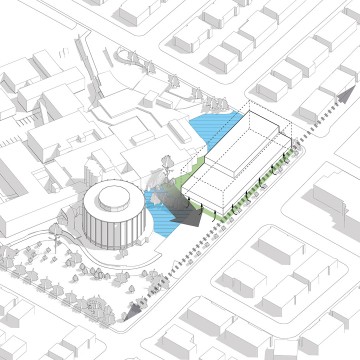
Program and massing
The chosen site for the expansion is located on the corner of Saint-Zotique and Pontoise streets and is the best suited solution to maintain essential links between the surgical suites and the other units as well as to enable efficient medical logistic flows.
In term of urban integration, the building massing was created with respect of the surrounding built environment. The last floor, hosting solely the main mechanical room, is recessed on the southern and western facades in order to maintain an overall human scale and clear the views toward the iconic Santa-Cabrini Ospendale hospital (HSCO) rotunda. The clear, logical, and functional massing enables flexibility and efficient circulation for the surgical suites staff and for handling of medical material to the device reprocessing unit (MDR).
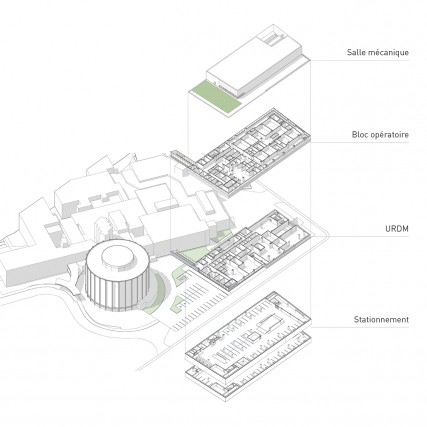
The building has two underground stories to accommodate parking spaces and mechanical rooms. The MDR is located on the main floor, second floor features the surgical suites and the third floor is dedicated to the main mechanical room.
In constant search for building mechanical integration strategies, and in accordance with the site limitations, the professional team managed to utilize the full potential of the available space. Materials and coloring selected for the envelope harmonizes with the existing hospital through the chalk and blue brick masonry.
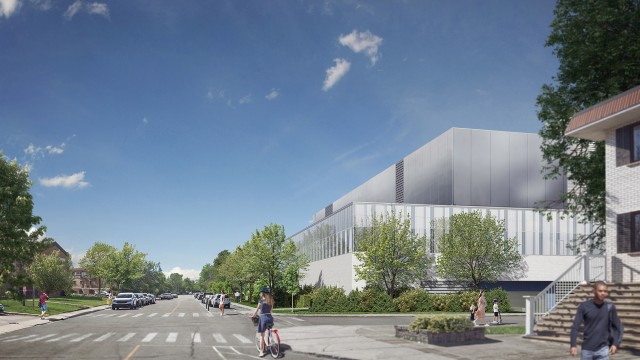
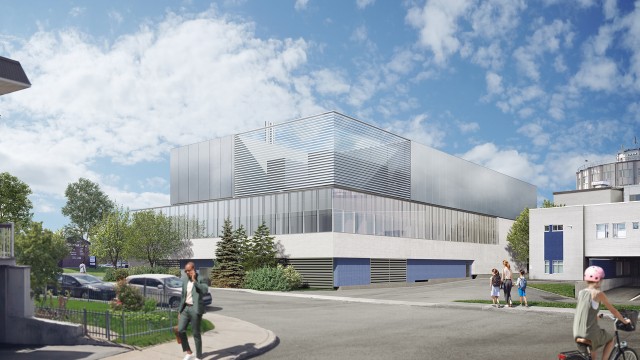
Natural light and well-being
The design team took to heart creating environment supporting the well being of patients and staff. Spaces have been planned to be efficient, all the while offering a healing environment and a pleasant and stimulating work place. Most offices, reception desks, nursing stations, rest areas and waiting rooms have outdoor views, as well as all circulations were possible. The waking room (a large open area) was placed so it would bring in as much natural light as possible. Measures were taken to maximize natural light for larger areas where outdoor windows were not possible, such as glazed walls for closed-off spaces near outdoor windows.
Besides nurturing well-being and comforting, access to outdoor views facilitate intuitive wayfinding, which in turn contributes to reducing stress and anxiety. In order to create a warm atmosphere for the facility, wood (or composite materials) were used for interior surfaces in accordance with the Politique d’intégration du bois (policy for the integration of wood within construction) while following infection prevention and control principles.
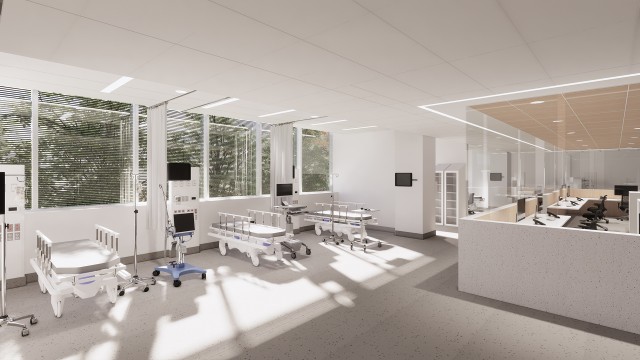
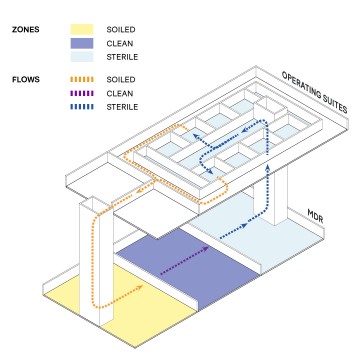
Medical logistic, efficiency and comfort
The medical devices reprocessing unit (MDR) asses the decontamination, disinfection, storage and distribution of instruments and other medical items requiring reprocessing in order to be used for dispensing care, including those required for surgical suites. It is therefore essential that the latter be functionally connected to the MDR: surgical suites and MDR are to be next or on top of one another to enable proper functioning. In the instance of the expansion of HSCO, the MDR unit is placed directly below the surgical suites in continuity with the existing activity already taking place on each floor. Vertical transportation allows for clear separation of clean and soil circulation to avoid potential crossing that may eventually cause contamination.
Comfort wise, layout of the different functions has been studied to avoid any hinderance. Standardize same-use spaces facilitate work flow, reducing stress amongst staff member and potential handling errors. Surgical suites, work stations and processing stations of the MDR unit are therefore planned the same way to enable activity standardisation from one room or station to another.
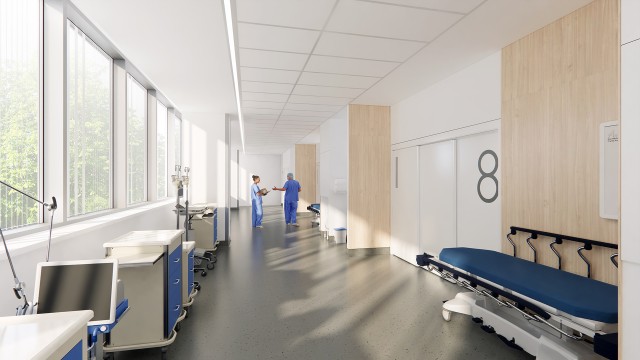
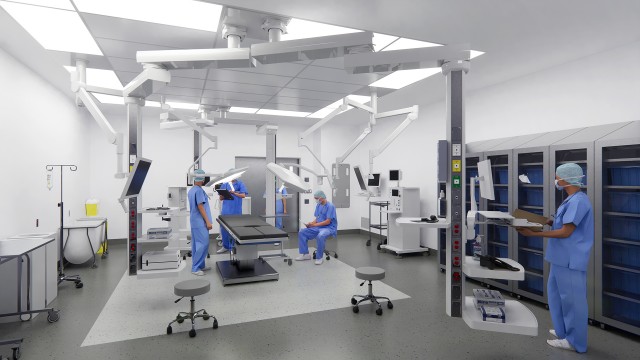
Materials and interior finishes are easy to maintain and are adapted to infection prevention and control required for medical facilities, but also to the establishment’s own standard, building practices and technical requirement for medical centers.
Accessibility is fostered for everyone (patients, staff and visitors) through ergonomic and adapted design.

Sustainability
Principles for sustainable design were solicited in order to ensure perennity of the premises, as well as providing all users with a healing environment, notably through the chosen systems and material. Anticipating the potential replanning that could take place throughout the building’s life cycle and to accommodate configuration changes needed by ever-evolving needs, same usage rooms were grouped as much as possible to enable future spatial flexibility.
A close attention was paid to preserving existing trees on site and maximizing vegetation around the new building as well as in the outdoor parking spaces to help reduce heat island. This approach allowed for a continuity with existing plantation along St-Zotique and Pontoise streets and to minimize the visual impact of a new institutional facility and parking to the residential neighbourhood.
Sustainable measures integrated as part of LEED v4 certification:
- Priority given to natural lighting, quality exterior views and the creation of relaxation areas for the well-being of users
- Preservation of trees on the site
- Complete decontamination of the site, improving the quality of the environment for occupants, fauna and flora
- 10% reduction in the carbon footprint of materials, thanks to a life cycle analysis of the building
- Use of sustainable and responsible materials (recycled, local, certified), limiting the impact on natural resources
- Low VOC materials and mercury-free lamps for better indoor air quality
- 75% of construction waste recycled or recovered, with a waste management plan
- Gender-neutral toilets planned, promoting inclusion and accessibility
- Secure bicycle parking spaces and reserved car-sharing spaces to support sustainable mobility
- 27% reduction in indoor water consumption and no outdoor irrigation required
- 13.8% reduction in energy consumption, despite intensive hospital use
Additional sustainable development strategies integrated into the project:
- White roof
- Optimisation of vegetation around the new building and in outdoor parking areas